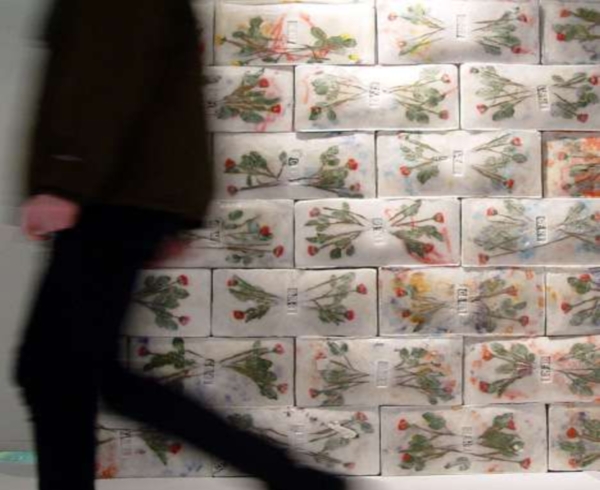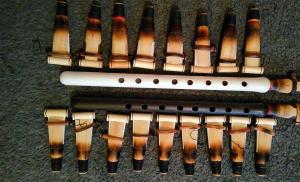Brick production waste. Making bricks from garbage is a business that makes the planet cleaner
Building from Waste is a book that won't make it to your weekend or vacation reading list, but some will find it rather interesting. Every year, human settlements generate 1.3 billion tons of solid waste. The book argues that they simply need to be used as cheap and durable building materials. Thanks to this, humanity can significantly reduce the level of environmental pollution.
Co-authors Dirk Hebel, Marta Wisniewska and Felix Hayes have taken a closer look at the construction industry and come up with a garbage science designed to find new and interesting building materials that can usually be found in landfills. The book claims that in the future we could reuse almost everything, just as we once did when all waste was organic.
This approach will be especially useful in the future, when the population increases and the level of waste doubles. The following is a list of building materials that are most popular with the authors of the book.
newspaper tree
This development came from Norway, where more than 1 million tons of paper and cardboard are processed annually. The tree is created by rolling paper with insoluble glue. Further, something similar to a log is obtained, which is cut into boards suitable for work. The wood can later be further protected to make it moisture and fire resistant. As a result, boards can be used in the same way as a regular tree.
newspaper tree 
Roof of diapers
The good news is that you can still do something about the many diapers and hygiene products that we throw away all the time, even if they are dirty and disgusting. A dedicated recycling facility is capable of separating polymers from organic waste and can be used to create building materials such as the tiles in the photo above.
Blocks from packages
The photo shows building blocks completely made from old packages, which are quite difficult to recycle in any other way. Recycled bags or plastic packaging are placed in a special mold and then pressed together under high temperature to form a block. True, they are too light to be used for load-bearing walls, but they can separate rooms.
Building blocks from plastic bags 
blood blocks
The emergence of this idea was the result of the fact that the blood of animals is considered useless and is usually disposed of. However, due to its high protein content, it is one of the strongest biological adhesives.
British student Jack Monroe, who is studying to be an architect, suggests using dehydrated blood supplied in powdered form.
Then mix it with sand to form a paste. This can be especially useful in regions where there is a lot of blood left after the slaughter of livestock, and building materials are in short supply.
Making building blocks from animal blood 
Bottle building blocks
Here the idea is different, as it is based on consumer products that can later be used as building materials. Many companies are already making cube-shaped bottles to make them easier to transport.
However, the practical use of such material began with the Heineken brewery in the 1960s. Alfred Heineken visited a Caribbean island where open bottles from his beer were scattered everywhere, which he was not happy about. After that, the company switched to new bottles, as shown in the photo.
The neck is inserted into a special recess on the bottom, after which a closed line of bottles is obtained.
Wall made of bottles 
smog insulators
One of the biggest receptacles of waste is air, which becomes of little use to our lungs. And also the greenhouse effect, which raises the temperature on the planet to unsuitable for the human race. Dastyrelief is a system that was created in the city of Bangkok. The idea is to place electrically charged grids on buildings that attract smog particles and stick them together. As a result, something similar to gray fur is formed on the buildings. It's not particularly attractive, of course, but it's better than anything that could form inside your lungs.
"Grey Fur" 
Mushroom Walls
Designers have found a way to grow insulation and packaging materials from mycelium. These are bacteria that can be found in decaying organisms such as tree trunks and agricultural by-products. If placed in a mold, these organics grow to their desired shape in just a few days, and then the growth can be stopped with a hot oven.
Mushrooms as building material for walls 
Plasfalt
It sounds funny, but the thing is really interesting. Plasfalt consists of grains derived from unsorted plastic waste that replace traditionally used sand and gravel. During the tests, it was found that the roads made of plasfalt are much less subject to wear, and this is all because the plastic granules are connected much better than the same sand and gravel.
Photo of plasfalt 
wine cork panels
These wall or floor panels are made from a combination of recycled and whole wine corks, which you can see in the photo. This is a pretty good idea, as more than 31.7 billion bottles of wine are consumed every year.
wine cork panels 
Brick has always been and is, perhaps, one of the most popular building materials, starting from 3-2 millennia BC and ending today. And this is not surprising, given its combination of qualities - versatility, reliability, excellent performance, nice price.
At any time of the year, there is a stable demand for this material, so the brick production line is quite a profitable business. In addition, despite decent competition, the current growth in construction enables entrepreneurs to successfully create and develop their business. Why not take a chance and try? Especially for those who have decided, in the framework of our article we will discuss the main points that you need to know before you start dealing with organizational issues.
Methods for making bricks or the future range of your production

By definition, a brick is a stone of artificial origin, made from mineral components and having a rectangular shape. However, external indicators, performance properties and the method of manufacturing products may vary.
Way of execution:
- silicate brick. The main components are water, quartz sand and air lime.
- Ceramic brick. Made from clay.
- . Wastes from asbestos, metallurgical, cement and mining industries are used as raw materials.

Scope of application:
- Building bricks (solid and hollow) are indispensable for laying wall structures, furnaces and other structures.
- is a smooth bar with many voids in the "body", due to which it is very light and successfully used for finishing and decorating buildings.
- Clinker - used to cover roads and decorate the exterior of buildings.

Main characteristics:
- By the type of surface, a brick happens - smooth, embossed, with a chipped texture.
- By color - white (silicate), red (clay) and yellow.
- In size - single, one and a half, double (for example, double silicate brick M 150), non-standard.
- Based on, there are the following brands of brick - F15, F20, F30, F50, F100.
- Based on water absorption - the range of this indicator can be in the range from 6 to 16%.
Ceramic brick - a traditional way of making

The clay brick business is perhaps the most expensive in all plans (free space, equipment, fuel, electricity, raw materials, number of employees, etc.). However, it is also the most cost-effective - high production capacity makes it possible to quickly recoup all the funds spent.
The main component for ceramic bricks is clay, which, depending on the deposit, can be of different quality. It is the proportion of clay in the composition of bricks that determines the quality of the products themselves.
For example, air-dried green bricks are usually composed of clay and straw, and therefore have a low content (less than 30%) of the main component. It is clear that the properties and durability of such a brick will be much less than that of terracotta products, which are 75% clay.

Ceramic bricks are produced by the plastic forming method. For a better understanding, consider this technology in stages:
- First of all, raw materials are prepared– the clay is moistened with steam and carefully processed until a plastic mass is obtained, without large stony particles (this procedure replaces the traditional aging process).
- Then the raw brick is formed. The pre-formed clay tape is cut by an automatic extruder. At this stage, the size of the bricks is slightly larger than standard, as subsequent processing (drying and firing) will shrink them.

- Drying is perhaps the most difficult and important stage of production. After all, you need to dry slowly, make sure that the rate of evaporation does not exceed the rate of its migration from the inner layers. And if this instruction is not followed, the brick will simply spread. As soon as the moisture content of the product is 6-8%, it can be sent for firing.
- The final stage is roasting. For this purpose, kilns of various designs are used: these are ancient ring kilns, in which bricks are placed and removed with their own hands, and modern tunnel units, where products are fired as they move through the kiln. The firing temperature is completely dependent on the composition of the raw material (usually it ranges from 950 to 1000ºC).

After firing, the structure of the brick completely changes: now it is a stone-like artificial building material, durable, resistant to temperature extremes, moisture and has other irreplaceable properties.
It should be noted that ceramic bricks can be solid and hollow. What is the difference? The presence of voids not only improves the quality of the product (in particular, the reduction in mass and thermal conductivity), but also facilitates the production process. Bricks go through the drying process much faster, since voids make it possible to increase the uniformity of heating of the product. As a result, lower fuel consumption is not at the expense, but even for the sake of quality.
Silicate brick - technological nuances

As mentioned above, silicate products consist of air lime and quartz sand. In this case, the production of bricks is carried out according to the method of autoclave synthesis:
Components are taken in the following proportions: 9 shares of quartz sand, 1 share of air lime and various additives. Then all this is mixed and subjected to dry pressing, as a result of which the future brick is given a standard rectangular shape. Next, the workpiece is autoclaved under the influence of water vapor at a temperature of 170-200ºC and at a pressure of 8-12 atmospheres.

What is an autoclave? This is a steel installation having a horizontally cylindrical shape. In diameter, it reaches more than two meters, and in length - from twenty to thirty meters. From the ends of the autoclave is closed with lids, in its lower part there are rails along which loaded trolleys with finished products move.
By the way! Bricks, made exclusively from the main components (lime and sand), are white. To achieve other color solutions, all kinds of alkali-resistant pigments are added to the two components.
The uniqueness of the autoclave method of brick production is that it is possible to obtain products of various densities and strengths, while using the same components and processes for their processing. It all depends on temperature and pressure.

The quality of the finished product is evaluated according to its technical characteristics:
- The compressive strength of the product should not be less than 15-20 MPa.
- Average density - not less than 1300 kg / m³.
- Frost resistance (i.e. the number of freeze-thaw cycles that a brick can withstand).
- Permissible application temperature - no more than 550ºC.
For the manufacture of silicate bricks, the following equipment is required:
- sand dispenser and bunker;
- dispenser and bunker for binders;
- twin shaft mixer;
- rod mixer;
- silo reactor;
- press;
- autoclave;
- automatic stacker;
- transfer trolley for loading trolleys;
- conveyors.
The production capacity of such a line is 20 million tons of products per year. However, for its normal operation, you need to hire more than twenty employees (at the rate of 10 people per shift).
Attention! In addition to working hands, you can not do without a driver, sales manager, accountant, storekeeper and cleaner. Of course, one person will not be able to monitor all the processes related to production.

In addition, it is necessary to take care of the supply of fuel (more than 700 tons per year), a separate building for a brick factory and a truck with a truck crane for loading, transporting and unloading building materials.
In general, in order to organize a silicate brick production in Russia, less space will be required than, for example, for the construction of a ceramic factory. In addition, it consumes 2 times less fuel and 3 times less electricity, and the manufacturing process itself is 2.5 times less labor-intensive and time-consuming. Thus, compared with ceramic bricks, the cost of silicate products is reduced by about 25-30%.
Hyper-pressed brick as an alternative

If at the moment you do not have enough capital to build a ceramic or silicate brick factory, then there is the most budgetary option for organizing a business - the production of hyperpressed bricks.
In this case, you will need the following equipment:
- concrete mixer;
- cement dispenser;
- installation for formation;
- stove with two sleeves;
- feeder-dispenser;
- compression unit;
- receiving and service bins;
- conveyors;
- crusher;
- lifts.
The minimum cost of the equipment listed above is approximately 10 million rubles. The production capacity of the line is about 4 million items per year.
Important! It is better not to save on technology. Used equipment, although it costs much less, but regular repairs and, as a result, downtime will make production unprofitable.
To accommodate all equipment, as well as to store finished brick products, at least 400 m² of free space will be required, where the ceiling height will be 5-6 meters or more.

At such a mini-plant, as a rule, waste from the asbestos, metallurgical, cement and mining industries is taken as raw materials. All costs are paid back in about two years, and the benefit of brick production by the hyperpressed method is about 20%. However, the profit from such an enterprise, of course, will be less than from a large ceramic or silicate plant.
So, regardless of which manufacturing method you choose and what products you will create (for example, the production of facing bricks) - in any case, you will need to consider the following points:
- The organization of any business begins with the preparation of project documentation. This also includes a business plan for production, during the preparation of which the prospects for the future enterprise, potential profit, and possible pitfalls will be determined. Also, it should clearly spell out the production process and technical and economic calculations.
- Search for a suitable room with an area of at least 500 m² and a ceiling of at least 5 meters to comfortably accommodate the production line. The most rational solution for the first time is to rent an abandoned workshop, plant, factory, out-of-town warehouse, and so on.

Note! The room for brick production should ideally be divided into three zones: a warehouse for raw materials, a workshop for production, a warehouse for finished products.
- Search for a supplier of the necessary equipment, depending on which production method is chosen. Today, there are no difficulties in this, since such equipment is sold in almost every region of the country. However, remember that it is better to purchase it from trusted suppliers located near you. Thus, you will simplify the delivery and further maintenance of the units.

- Hiring workers, even though brick production is semi-automated. We have already mentioned the number of workers and managers above.
- Immediately before the start of production, it will be necessary to conduct laboratory research and testing of raw materials, and then, on their basis, develop an appropriate regulation.
- Another important question is where to put the brick production waste? Perhaps the most rational solution is to export them to secondary PET. For example, broken bricks make excellent roof tiles. Regular small profits in the "piggy bank" of your budget.
Conclusion

Brick production is a great idea for starting your own business in the construction industry. The main thing is to analyze everything well, plan and organize. Then the demand for products will quickly increase, and investments will pay off in a matter of time, and regular profits will grow.
We wish you success in your promising endeavors! And in the presented video in this article you will find additional information on this topic.
Production of bricks from garbage as a business
In recent years, large industrial enterprises have often been blamed for the damage they cause to the environment. Apparently, therefore, now more and more business ideas have begun to appear, in which mass production is combined with benefits for the environmental situation on the planet. One of these business ideas can be called the manufacture of building materials from the waste of other industries, and simply speaking from the garbage.
Let's look at one of the already existing types of production of such building materials - bricks and blocks from recycled materials.
How can "garbage" be used to make bricks?
I would like to note right away that all examples of the production of bricks and blocks from the waste of various industrial productions are at the start-up level. But all these are more than promising projects, each of which can grow into a highly profitable business.
And immediately I want to consider why such a business has great prospects:
Cheap raw materials. What will become the raw material for the manufacture of your products is considered by other manufacturers as waste that needs to be disposed of, spending their own resources on it. Offer such businessmen or municipal organizations waste disposal services, and you will provide yourself with cheap raw materials.
Opportunity to win tenders. If you have to participate in tenders to start a business, then it will be on your side that with your production you will improve the environmental situation in the region and provide the market with affordable building materials.
Wide target audience. The building materials produced by you will be of interest for low-rise construction, the creation of sewer systems, the construction of workshops and industrial premises, etc. Demand will be provided at an affordable price, which is 10-15% lower compared to traditional building materials.
The prospects are great. Now let's look at how they are already being implemented in practice.
Examples of brick production from recycled waste:
Now consider several options for using waste for the production of bricks:
- Brick from boiler ash
This technology was developed at the University of Massachusetts, proved to be successful, and is now being implemented in construction work in the Indian city of Muzaffarnagar. Ash from the boiler house (70%) is used as raw material, to which clay and lime are added. Prior to this, boiler ash was simply buried in the ground. And now it can cost comfortable housing.
– Building waste blocks
The following example refers to the manufacture of wall blocks, not bricks. Production was organized in Vladivostok, where a plant for the production of building materials from construction and industrial waste was created. All this waste is fed into a shredder, crushed, turned into a homogeneous mass, after which blocks are formed from them for the construction of buildings.
- Paper bricks
The last example is still under development. From paper production waste and clay, a mass is created from which bricks are formed, then fired in a kiln. The technology was developed at the University of Jaen, and according to the reports of their researchers, it is possible to create reliable low-rise energy-efficient houses from this material. True, such bricks have a lower strength than traditional ones, which requires additional solutions in reinforcing the walls of the future building.
The business idea of making bricks from waste is an industry that requires exploratory courage, technical savvy and entrepreneurial genius. But if you manage to implement such a project, then you can take a dominant position in an emerging market. And if you prefer a fully developed production of building materials, then it makes sense to start manufacturing foam concrete blocks and other traditional wall materials.

Levi's jacket from a military parachute
The Levi's brand released a windbreaker made of parachute material. The classic Tucker model is modeled after a truck driver's jacket, but it was created from decommissioned military parachutes that were cut and sewn into a khaki windbreaker.
The Levi's brand has already been created, using more than 10,000,000 PET bottles in the production of its clothes. In 2012, the company launched the Levi's Wasteless line, each item of which contained at least 20% recycled material, which corresponds to about eight plastic bottles.

Fuel from plastic bags
Scientists at the Illinois Center for Sustainable Technology have developed a method by which plastic bags can be recycled into quality fuels, gas and other useful hydrocarbon products. At the same time, much less energy is spent on the transformation of plastic than it is produced from.
The resulting gasoline can be blended with biofuel, which will greatly improve its environmental performance. Bags can also be raw materials for the manufacture of solvents, waxes and lubricating oils. The technology for making fuel, invented by American scientists, involves heating packages in an oxygen-free chamber.

Elephant dung stationery
The Taman Park in Bali and the Indonesian Safari Park make paper from elephant dung. The resulting products are environmentally friendly and have all the necessary quality certificates.
Up to 2.5 tons of elephant dung accumulate daily in both parks, part of which goes to fertilizer and the rest to paper production. Elephants can only partially digest grass, and therefore their fibrous dung is suitable for processing. Each individual eats about 180 kg of greens per day, and gives out about 110 kg of potential material.

Decorative tile from cathode ray tubes
With the development of high technology, the screens of computers and televisions with cathode ray tubes have been replaced by flat LCD monitors. At the same time, it is cathode ray tubes that are one of the most hazardous and difficult to recycle waste in the world. In the United States of America alone, about 390 million kilograms of CRTs have accumulated.
The American company Fireclay Tile, which manufactures decorative tiles from recycled materials, has come up with the idea of using cathode ray tubes in the manufacture of its products. The tile turns out incredibly strong, durable and eco-friendly.

Fishnet Skateboard
American skateboard company Bureo will release the world's first skateboard made from recycled fishing nets. The production of one skateboard will take about 30 square meters of old nets collected on the coast of Chile.
It is similar in design to a fish with a "tail" and a scaly pattern. The board's wheels will be made from 100% recyclable material. It is 30% vegetable oil.

Jellyfish towels and diapers
The Israeli company Cine'al has created a natural material hydromash from jellyfish, which can be used in the production of baby diapers, towels and diapers. Jellyfish contain up to 90% moisture in their body, which makes them the most watery creatures in the world. Their body stores fluid in tissues, absorbing water like a sponge.
The creators of the project calculated that about 70 kilograms of diaper waste per year per child. Unlike the synthetic materials from which they are made, the hydraulic machine is completely environmentally friendly. It decomposes naturally within 30 days. Cine'al promises that their invention will be inexpensive.

smog ring
Dutch designer Daan Roosegaarde created jewelry out of smog. To do this, he developed a special vacuum system that sucks urban soot right out of the air, and placed the collected particles in artificial crystals for the rings.
The created decorations are designed to remind people of environmental pollution. They clearly show the composition of the air we breathe. All the smog for the rings was collected in Beijing, where the problem reached a critical point.

Eco-friendly toilet cement
She learned from Brazil, Spain and England how to make eco-friendly cement from old toilet bowls and other ceramic waste. The resulting solution is stronger and more durable than the cement that is currently used in construction.
It is made by grinding ceramic waste, which turns into dust and mixes with water. Then an activator is added - a mixture of sodium hydroxide and silicate. The resulting mass is poured into a mold and subjected to intense heating.

Bamboo toilet paper
The American company Nimbus Eco has developed eco-friendly paper from bamboo and sugar cane. It is suitable for the production of toilet paper, napkins and disposable towels. Bamboo makes the products durable, while sugarcane fibers give the paper the necessary softness for the skin.
According to research, the average American uses over 23 rolls of toilet paper every year. If every resident of the United States replaced at least one roll of ordinary toilet paper with bamboo paper, he would help save about 470,000 trees a year.
A hundred years ago, the word "brick" did not cause a variety of definitions. Brick was called, in a modern way, a product made of baked clay. These are the old and good building material, which is still considered the most reliable and "noble". In the 20th century, the meaning of this word expanded significantly, because a variety of bricks began to appear. For example, white silicate brick based on quartz sand and lime. In Soviet times, such material was used very widely. It did not require high temperatures for production, and therefore was cheaper. True, the consumer perceived it as a kind of "ersatz", a kind of "plebeian" replacement for normal ceramic bricks. And this is despite the fact that in low-rise construction, the new material has proven itself well. He was quite strong and reliable. But, unfortunately, "not friendly" with fire and water.
The development of modern technology has gradually led to the fact that different types of bricks began to appear as if from a cornucopia. In principle, any rectangular product that could be lifted with one hand began to be called a “brick”.
Some craftsmen manage to make "bricks" out of sand and cement - without any autoclaving. Special molds are used for this. Once - and you're done! For individual construction, this method is not so bad. You can organize such a mini-production in your yard and make such “bricks” alone. Then lay out the wall alone. A glance is simple!
But still, as we understand it, normal material should be produced at enterprises, and not in a handicraft way. And here the issues of economy are already important. Ceramic brick - with all its advantages - is still a costly material. There is no talk of mass application these days, no matter how the consumer treats it. About five years ago, calculations were made in our region, which showed that the cost of a brick house would be at the level of 40 thousand rubles per square meter. That is, no "economy class" of brick is possible. Of course, there are a variety of combined options, with the use of heaters: "layered" masonry, "well" masonry. But, as we understand, this is not the same at all. "Nobility" here is already imaginary, for appearances. And the reliability of such structures in general raises serious doubts.
Some manufacturers, meeting consumer demands, specialize in the production of porous and hollow bricks that do not require additional insulation. But even builders have complaints about such material. Its strength is less, and in addition there is a vulnerability to moisture.
From the point of view of construction, the main advantage of a brick is precisely in the reliability of such a design and the relative ease of installation, which does not require the use of any complex devices. After all, the technology of erecting brickwork has not practically changed for thousands of years, since the time of King Nebuchadnezzar. That is why it is usually attractive to individual developers, that, having mastered some skills in laying bricks on a mortar, you can lay out a wall yourself.
In our country, where there are a lot of "handy" men, citizens on their plots would build plenty of houses and other buildings for themselves, if there were plenty of this material at hand - reliable and, most importantly, inexpensive. However, here one with the other - reliability and cheapness - do not grow together in any way.
A good ceramic brick for the average Russian is expensive in any case. I would like to sometimes bungled something, but it's expensive. We have to look for a cheap replacement. And a cheap replacement, as we understand it, is not reliable.
However, progress does not stand still. In many countries, attention is now being paid to waste from industrial and energy enterprises as a source of raw materials for the production of inexpensive materials. For example, in the United States, about eight years ago, they developed a technology for the production of so-called "green" bricks from ash and ash. In terms of its properties, it is in no way inferior to ceramic bricks - it is just as durable and reliable, it can endure both heat and cold without any problems. But at the same time - several times cheaper. In addition, the mass production of "green" bricks makes it possible to profitably dispose of industrial waste, of which 50 million tons are accumulated annually in this country.
There is nothing new here, of course. It's just that the era dictates its conditions. Manufacturers are usually conservative in such matters. The use of recycled materials is perceived as something secondary and "unclean". Digging through the waste, it seems, is not a "master's business." That is, this problem, first of all, is not technological, but psychological. Usually the waste was used as an additive for road construction. Now the question is raised about how to produce specific products on their basis. And it must be assumed that time works for this approach. After all, for the mass production of "green" bricks, you do not need to dig a quarry. On the contrary, such production makes it possible to cleanse nature of rubbish.
The same trend is observed in our country. Ashes and slags were used in road construction even in Soviet times. And materials such as cinder blocks and cinder concrete are very well known to our consumers. True, their production to this day is of a semi-handicraft character.
A "serious" producer works, as before, with the material that is extracted in quarries. But in any case, time will take its toll. In Omsk, for example, they have already begun to produce "green" bricks from the ashes and slags of the thermal power plant. A very telling precedent.
To consolidate this trend, it is necessary that science has its own weighty word on this issue. It should be noted that the Institute of Solid State Chemistry and Mechanochemistry of the Siberian Branch of the Russian Academy of Sciences has been eyeing industrial waste for a long time. For example, the rubble of the metallurgical enterprises of Kuzbass is generally considered by the Institute's specialists as a "Klondike" for our construction industry. In particular, samples of refractory bricks with a density of 2 G/CM3 and linear dimensions: 380X130X120 were obtained from metallurgical scrap using a silicate binder. According to Vladimir Poluboyarov, a leading specialist of the Institute, industrial waste is quite suitable for the production of inexpensive bricks and even decorative tiles (“artificial granite”).
The resulting brick is not inferior in strength to ceramic bricks and is just as reliable in operation. It will, of course, be cheaper. Savings are achieved mainly due to the fact that the production of such bricks does not require high temperatures. 300 degrees Celsius is enough to get a product with acceptable strength characteristics. While for firing ceramic bricks it is necessary to “ensure” at least 900 degrees Celsius. Note that in our time, energy costs are one of the main items of production costs. And these costs will certainly only grow. In this regard, traditional ceramic bricks should be perceived as a "relic of the past." And the fate of numerous brick enterprises, by and large, is a foregone conclusion - as energy prices rise, nothing good shines for them. A new, more progressive, in any case, will make its way. According to Vladimir Poluboyarov, if the technology proposed by the Institute were widely used, we would get a “penny” building material that is in no way inferior to “noble” brick.
It is clear that investors who have invested a lot of money in brick production (and there are already at least 15 brick factories in the NSO) would not be happy at all with such competition. At the same time, we do not think that the Russian consumer is so spoiled that he would perceive the "green" brick (we will use this term) with skepticism and distrust. Well, if in the provinces citizens build their own houses and garages from substandard (it's cheaper), then a solid inexpensive material would be received positively. There is no doubt here. Scientists are ready to contribute to this process. It's up to the manufacturers. Technically, nothing prevents the installation of automated lines in production that works with













